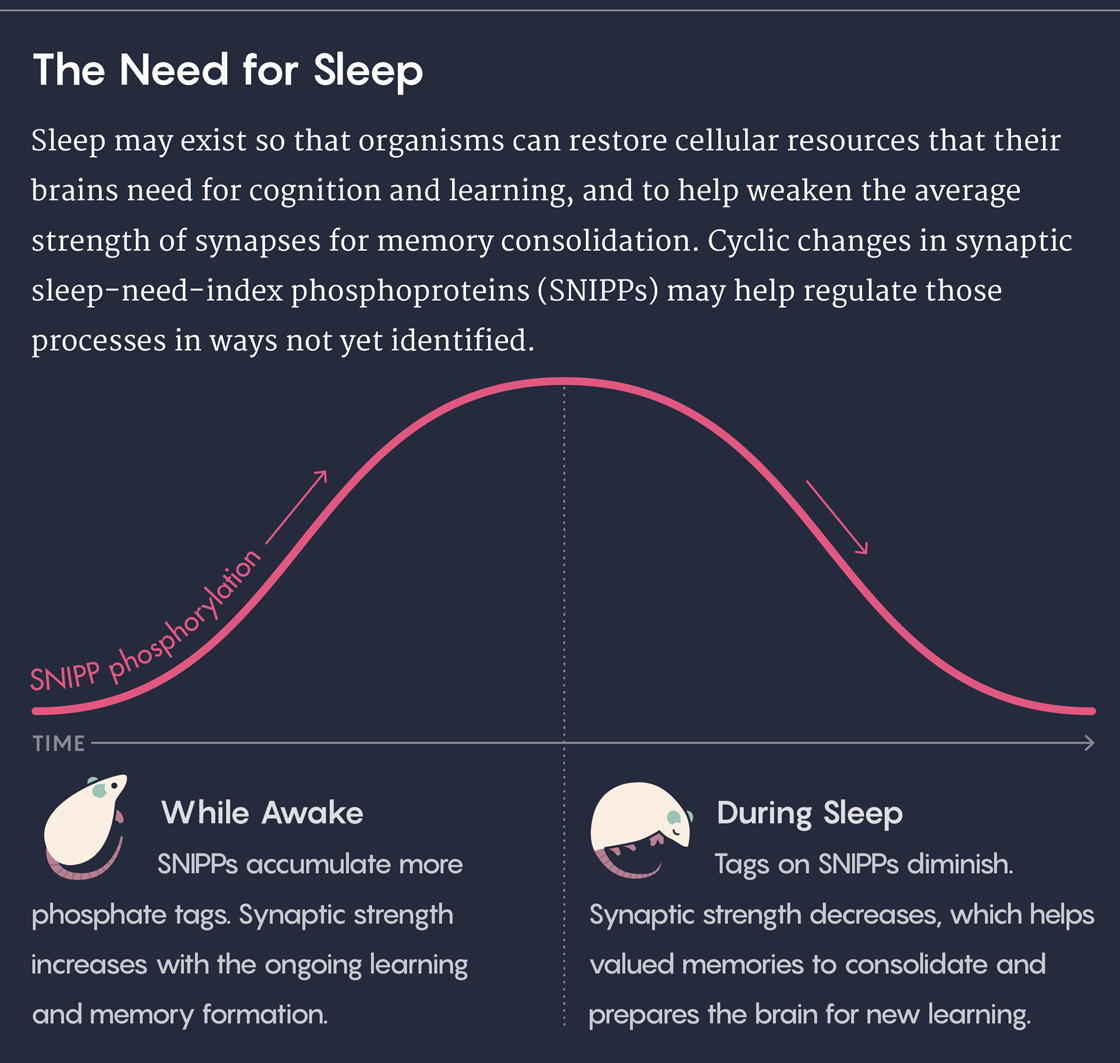You Are Getting Sleepy — Tagged Proteins May Point to Why

Sleep is essential for normal learning and health, yet scientists still do not entirely understand what it does to help restore the brain or what makes us feel sleepy. Some important clues are emerging, however, from biomolecular studies of mutant mice with an unusual need for sleep.
Camille Chew for Quanta Magazine
Introduction
Two years ago, scientists in Japan reported the discovery of a mouse that just could not stay awake. This creature, which had a mutation in a gene called Sik3, slept upwards of 30 percent more than usual: Although it awoke apparently refreshed, it would need to snooze again long before its normal lab mates’ bedtime. It was as if the mouse had a greater need for sleep.
Now, after examining the brain chemistry of sleep-deprived mice and the ones with the Sik3 mutation, a second research group at the International Institute of Integrated Sleep Medicine at the University of Tsukuba has identified tantalizing differences in the state of 80 proteins that well-rested, normal mice do not share. That observation, the scientists suggest, may be the key to understanding at the molecular level both why we need sleep and why we feel sleepy.
Researchers can describe in generalities many things that happen in sleeping brains. The connections between neurons shift. On electroencephalograph recordings, sleep-deprived brains produce slow waves with higher peaks and lower valleys than well-rested brains do. The body produces certain substances that will knock you out, and others that will wake you up. Sleep helps with learning, and, despite the fact that it takes us out of commission for a shockingly large proportion of each day, it’s necessary for survival. If we go without it for too long, it’s likely we will die.
What remains surprisingly murky, however, is what precisely sleep does that’s so important, and how the brain keeps track of how long it’s been awake. Presumably, the mechanism of that internal ledger of sleep need is connected to whatever processes are restored during sleep.
The new results hint that some leads on the problem might emerge from a biochemical approach — specifically, checking out phosphorylation, the attachment of phosphate groups, to those 80 identified proteins (and possibly others). Phosphorylation commonly turns off or otherwise modulates the activity of proteins, so it’s possible that in this case it is altering how some of these proteins function.
Less Sleep, More Phosphorylation
The scientists began their experiments already suspecting that it might be fruitful to look at phosphorylation in mice with the Sik3 mutation, which they aptly call Sleepy mice. Sik3 codes for an enzyme that adds phosphate groups, and the mutation that the Sleepy mice have makes the enzyme overactive — potentially causing it to add more phosphate groups than normal. That sleepiness “indicates there’s something wrong or changed in phosphorylation in these mutant mouse brains,” said Qinghua Liu, a co-author on the paper and a professor at the University of Texas Southwestern and the University of Tsukuba who recently moved to the National Institute of Biological Sciences in Beijing.
Their experiments compared Sleepy and normal mice that were either well-rested or in various states of sleep deprivation. The researchers first found that in the brains of sleep-deprived mice and Sik3 mutants, a similar subset of phosphorylating enzymes was active. Then they looked at all the brains’ phosphorylated proteins and found that while roughly the same proteins were present, their tagging looked different. Sleepy mice and normal mice differed significantly from each other, as did sleep-deprived mice and well-rested mice. In particular, sleep-deprived mice had more phosphorylation; Sleepy mice, for their part, had many proteins that were more phosphorylated than in normal mice, while others were phosphorylated less.
In all, 80 proteins were more phosphorylated in both Sik3 and sleep-deprived mice than in controls. The researchers dub these “sleep-need-index phosphoproteins,” or SNIPPs. They found in follow-up experiments that the longer a mouse was awake, the more these proteins were phosphorylated.
Intriguingly, nearly 80 percent of the proteins — 69 of them — are involved in the synapses, the places where neurons connect to one another. That’s a much greater proportion of synaptic proteins than in the brain taken as a whole, and it hints at the link, much discussed in the sleep community, between regulation of the synapses and sleep.
A theory called the synaptic homeostasis hypothesis suggests that while being awake allows synaptic connections to form through learning and making new memories, being asleep allows some of those connections to be pruned back or weakened, consolidating and strengthening the memories that matter. Some studies suggest that sleep primes synapses for greater activity during wakefulness. Chiara Cirelli, a professor at the University of Wisconsin, Madison, and the Wisconsin Institute for Sleep and Consciousness, who is one of the synaptic homeostasis hypothesis’s originators, said of the new paper, “It is strong evidence that sleep need is related to synaptic activity.”

Lucy Reading-Ikkanda/Quanta Magazine
What exactly that extra phosphorylation leads to in the brain, and for that matter why being awake would make phosphorylation happen, is still unclear. How phosphorylation changes the effects of each SNIPP isn’t yet known. Still, the SNIPP called synapsin-1 offers an interesting example of what changing phosphates can do.
At a synapse, the “upstream” neuron will contain many little bubblelike vesicles of neurotransmitters, which wait around for a signal from afar. When that signal comes, they rush to the neuron’s membrane and release their contents into the synaptic gap, where they are received by the other neuron, passing on the message. Synapsin-1 sits on the surface of those vesicles. When it gets phosphorylated, they edge closer to the membrane.
“Maybe what’s happening is that these changes are about priming neurons for action,” suggests Thomas Scammell, a sleep researcher and clinical neurologist at Harvard Medical School. One interpretation might be that wakefulness depletes the levels of neurotransmitters close to the synapse; in that case, phosphorylation might both regulate the arrival of new supplies and in some fashion mark how active the brain has been. (It’s worth noting, however, that no single protein on its own is likely to provide a complete explanation for a process as biologically global as sleep need.)
A Molecular Explanation for Sleep Need
Overall, it’s an impressive paper, said Jonathan Lipton, who is also a professor of neurology at Harvard Medical School. It’s clear that the researchers are aiming at the long-sought goal of a molecular explanation of sleep need. “The argument they’re making in this study is that they see these changes in certain synaptic protein signaling cascades that seem to correlate with increasing sleep need,” he said. “What constitutes the brain’s need for sleep on a molecular and neurological level? Obviously, that’s what they’re addressing.”
Lipton and Scammell both express some qualms about the fact that the method used to keep the mice awake — placing them on shaking tables — isn’t stress-free. Using Sleepy mice for an unstressed comparison should help deal with that issue, but Scammell wondered whether the same SNIPPs would emerge in mice deprived of sleep in gentler ways, such as tapping on their cage or giving them something to play with.
If phosphorylation does prove to be important for tracking sleep need, as the study suggests, it may be only part of the story. One protein that’s thought to be very important in the synapses during sleep deprivation, Homer-1, doesn’t appear on the list of SNIPPs at all, said Tarja Porkka-Heiskanen, a sleep researcher at the University of Helsinki. If Homer-1 doesn’t get its cues from phosphorylation, that could imply that several different biochemical systems handle sleep need, perhaps in complementary ways. Still, the method the researchers used does not necessarily pick up on the phosphorylation changes of every protein, so it is possible that Homer-1 may still have some differences.
Going forward, the researchers plan to look more closely at what the SNIPPs do. Twelve out of the 80 have already been found to alter sleep in some way in mice or people, but many others have not yet been investigated. These 80 are simply a list of candidates when it comes to identifying the players in the brain’s recording of sleep and wakefulness, Liu said. “Some of them may be more important than others. … Others may simply come along for the ride. So these still require future studies to sort out.”



